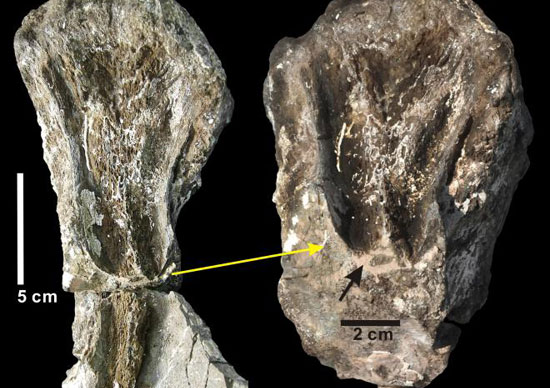Sign the largest dinosaur teeth in the world
South Korean researchers say they have discovered the world's largest carnivorous dinosaur tooth mark in the southeastern part of the country.

Signs of dinosaur teeth have just been discovered in Korea - Photo: Korea Herald
According to Yonhap news agency , the upper teeth were found on the caudal of a herbivorous dinosaur of Pukyongosaurus , which lived at the beginning of the Mid-year White Rabbit era. These teeth marks are 17 cm long, 2 cm wide and 1.5 cm deep.
The research leader, Professor Paik In-sung (Pukyong National University) affirmed that these are the longest and deepest dinosaur marks in the world discovered so far. The Pukyongosaurus dinosaur fossil was found in 2008 in Hadong district, South Gyeongsang province, about 470 km southeast of the capital Seoul.
The W-shaped markings show that the two teeth make sharp lines on the bones of the bait dinosaur. Many markings of all sizes and shapes are also found in the tailbone, allowing scientists to better understand the ' eating ' behavior of carnivorous dinosaurs that exist on Earth about 120 million years ago. year. ' The discovery of many tooth marks on a bone shows that carnivorous dinosaurs have a habit of sipping only one prey, similar to modern carnivores, ' said Professor Paik.
The results of the study funded by the Ministry of Education, Science and Technology of Korea were published in the American journal Palaeogeography , Palaeoclimatology , Palaeoecology . According to Yonhap, in 2009, Korean scientists also announced Discover the world's smallest dinosaur footprint. The Theropoda dinosaur fossil footprint, only 1.27 cm long and 1.06 cm wide, is 29% smaller than any footprint pattern found to date.
Paleontology experts said that dinosaurs lived in Korea about 80-120 million years ago, spent most of the year of the white chalk, the last stage of the mid-life and this is also their golden age. . Dinosaur fossils were discovered and conserved thoroughly on an area stretching across the southern coast of Korea.
- The teeth of tyrannical dinosaurs confuse the scientific world
- The teeth of dinosaurs resemble horse teeth
- Clean-falling dinosaur teeth when grown up
- Discover the world's largest dinosaur footprint in Australia
- Find the world's largest dinosaur footprint
- Video: Recreating the world's largest dinosaur with virtual reality technology
- The world's largest dinosaur footprint has been identified
- Close up of the world's largest dinosaur park
- Detecting the first individual cavities dinosaurs
- Video: The largest carnivorous dinosaur ever existed on Earth
- Where the largest dinosaur fossil in the world
- Discovering the first dinosaur fossil in Malaysia
 Discovered an ancient centipede fossil 99 million years old
Discovered an ancient centipede fossil 99 million years old Discovered bat-like dinosaurs in China
Discovered bat-like dinosaurs in China Discovered a 200-year-old bronze cannon of the coast
Discovered a 200-year-old bronze cannon of the coast Discover 305 million-year-old spider fossils
Discover 305 million-year-old spider fossils